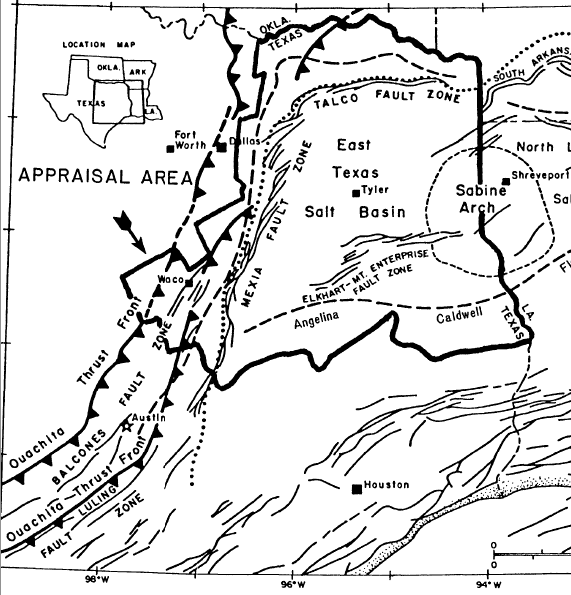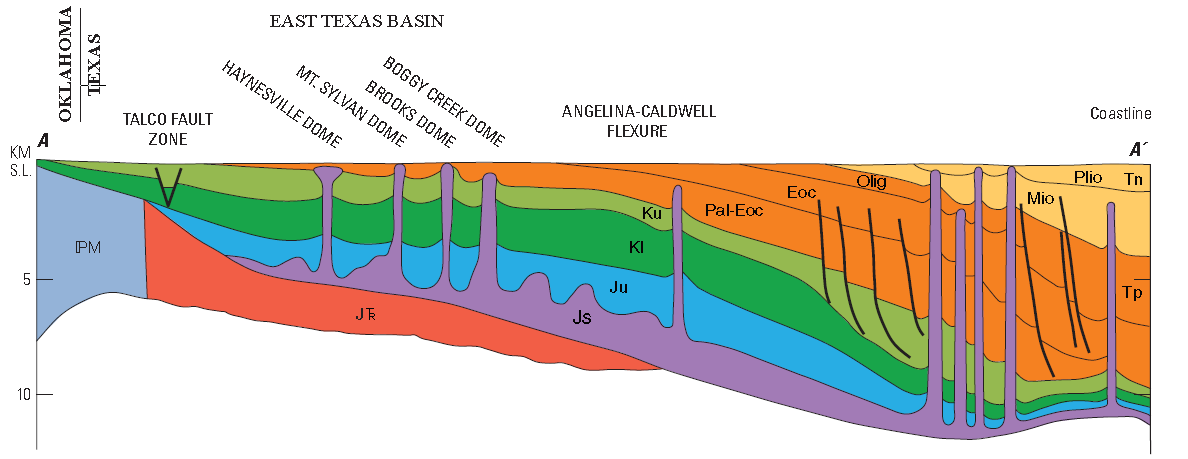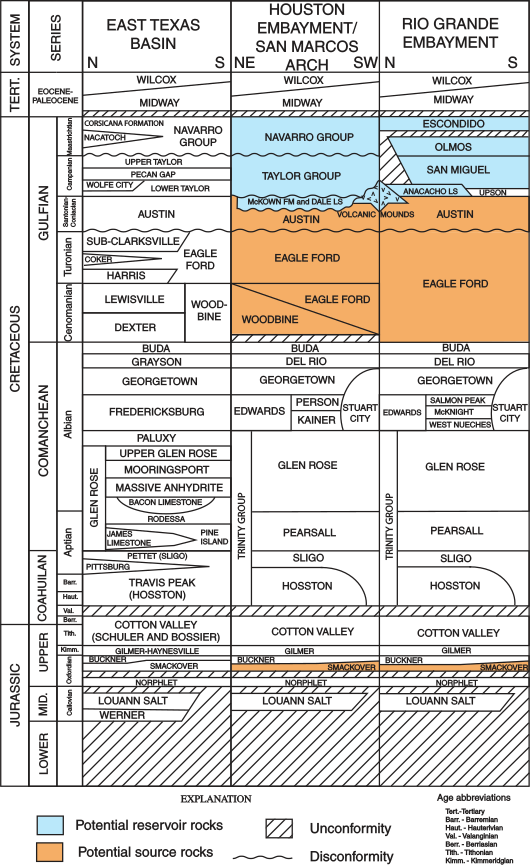East Texas Oil Field on:
[Wikipedia]
[Google]
[Amazon]

 The East Texas Oil Field is a large oil and gas field in east
The East Texas Oil Field is a large oil and gas field in east
 The primary productive geologic unit is the
The primary productive geologic unit is the
 Several early attempts were made to produce oil in the area, beginning in 1911, with the failed Millville Oil Company, but drilling technology had not progressed sufficiently to reach oil at the depths it is found there, which are mainly below ; most early wells ended in broken bits, dry holes, and bankrupt operators. Finally, an enterprising Alabama man, Columbus Marion (Dad) Joiner, was the first with enough persistence to succeed, and on October 3, 1930, his Daisy Bradford No. 3 well (named after the widow who owned the farm) hit oil at below ground surface. The well is located near the southeastern boundary of the oil field. This was the third well Joiner drilled, the first was abandoned at in February 1928, the second at in March 1929, but the second did show gas below . Joiner employed the driller Ed Laster for the third well, which was spudded in May 1929, only from the second site. Only about separated the second site from the first site. On 20 July 1930, Laster took a
Several early attempts were made to produce oil in the area, beginning in 1911, with the failed Millville Oil Company, but drilling technology had not progressed sufficiently to reach oil at the depths it is found there, which are mainly below ; most early wells ended in broken bits, dry holes, and bankrupt operators. Finally, an enterprising Alabama man, Columbus Marion (Dad) Joiner, was the first with enough persistence to succeed, and on October 3, 1930, his Daisy Bradford No. 3 well (named after the widow who owned the farm) hit oil at below ground surface. The well is located near the southeastern boundary of the oil field. This was the third well Joiner drilled, the first was abandoned at in February 1928, the second at in March 1929, but the second did show gas below . Joiner employed the driller Ed Laster for the third well, which was spudded in May 1929, only from the second site. Only about separated the second site from the first site. On 20 July 1930, Laster took a
East Texas Oil Museum
at Kilgore College
Gregg County's Oil FieldAmerican Oil and Natural Gas Historical SocietyEast Texas Oil Field Brochure
*

 The East Texas Oil Field is a large oil and gas field in east
The East Texas Oil Field is a large oil and gas field in east Texas
Texas (, ; Spanish language, Spanish: ''Texas'', ''Tejas'') is a state in the South Central United States, South Central region of the United States. At 268,596 square miles (695,662 km2), and with more than 29.1 million residents in 2 ...
. Covering and parts of five counties, and having 30,340 historic and active oil wells, it is the second-largest oil field in the United States outside Alaska, and first in total volume of oil recovered since its discovery in 1930.
Over of oil have been produced from it to-date. It is a component of the Mid-continent oil province, the huge region of petroleum deposits extending from Kansas
Kansas () is a state in the Midwestern United States. Its capital is Topeka, and its largest city is Wichita. Kansas is a landlocked state bordered by Nebraska to the north; Missouri to the east; Oklahoma to the south; and Colorado to ...
to New Mexico
)
, population_demonym = New Mexican ( es, Neomexicano, Neomejicano, Nuevo Mexicano)
, seat = Santa Fe, New Mexico, Santa Fe
, LargestCity = Albuquerque, New Mexico, Albuquerque
, LargestMetro = Albuquerque metropolitan area, Tiguex
, Offi ...
to the Gulf of Mexico
The Gulf of Mexico ( es, Golfo de México) is an ocean basin and a marginal sea of the Atlantic Ocean, largely surrounded by the North American continent. It is bounded on the northeast, north and northwest by the Gulf Coast of the United S ...
.
The field includes parts of Gregg, western Rusk
A rusk is a hard, dry biscuit or a twice-baked bread. It is sometimes used as a teether for babies. In some cultures, rusk is made of cake, rather than bread: this is sometimes referred to as cake rusk. In the UK, the name also refers to a w ...
, southern Upshur, southeastern Smith, and northeastern Cherokee
The Cherokee (; chr, ᎠᏂᏴᏫᏯᎢ, translit=Aniyvwiyaʔi or Anigiduwagi, or chr, ᏣᎳᎩ, links=no, translit=Tsalagi) are one of the indigenous peoples of the Southeastern Woodlands of the United States. Prior to the 18th century, th ...
counties in the northeastern part of the state. Overall the field is about long on the north-south axis, and five miles (8 km) to across. The producing sands were relatively shallow at about , was high gravity, low in sulfur, and yielded a high percentage of gasoline (up to 37 per cent). Interstate 20
Interstate 20 (I‑20) is a major east–west Interstate Highway in the Southern United States. I-20 runs beginning at an interchange with I-10 in Scroggins Draw, Texas, and ending at an interchange with I-95 in Florence, South Carolina. Bet ...
cuts across the field from east to west, and the towns of Kilgore, Overton, and Gladewater are on the field. At one time, downtown Kilgore had more than 1,000 active wells clustered in a tight area, making it the densest oil development in the world.
Geology
 The primary productive geologic unit is the
The primary productive geologic unit is the Cretaceous
The Cretaceous ( ) is a geological period that lasted from about 145 to 66 million years ago (Mya). It is the third and final period of the Mesozoic Era, as well as the longest. At around 79 million years, it is the longest geological period of ...
-age Woodbine Formation, a regional petroleum-bearing unit which had been known since the early part of the 20th century. This sandstone
Sandstone is a clastic sedimentary rock composed mainly of sand-sized (0.0625 to 2 mm) silicate grains. Sandstones comprise about 20–25% of all sedimentary rocks.
Most sandstone is composed of quartz or feldspar (both silicates ...
unit was deposited during a period when East Texas was a shallow sea
An inland sea (also known as an epeiric sea or an epicontinental sea) is a continental body of water which is very large and is either completely surrounded by dry land or connected to an ocean by a river, strait, or "arm of the sea". An inland se ...
, approximately 100 million years ago. During a subsequent period it was uplifted with the Sabine Uplift, eroded, and then covered again by the sea, which this time unconformably deposited a layer of impermeable chalk, the Austin Chalk, creating a stratigraphic trap – a situation where oil, which is lighter than water and migrates upwards, reaches a point where it can move no farther, and pools. The source rock for the oil in East Texas is the overlying Eagle Ford Shale.
Water intrusion from deeper in Woodbine Formation is the mechanism pushing oil through the reservoir toward the producing wells. A 1932 study showed that oil wells stopped flowing when water pressure dropped below 800 pounds per square inch.
More recently, the gas-rich Jurassic
The Jurassic ( ) is a Geological period, geologic period and System (stratigraphy), stratigraphic system that spanned from the end of the Triassic Period million years ago (Mya) to the beginning of the Cretaceous Period, approximately Mya. The J ...
Haynesville Shale has become the target of exploration and production.
History
 Several early attempts were made to produce oil in the area, beginning in 1911, with the failed Millville Oil Company, but drilling technology had not progressed sufficiently to reach oil at the depths it is found there, which are mainly below ; most early wells ended in broken bits, dry holes, and bankrupt operators. Finally, an enterprising Alabama man, Columbus Marion (Dad) Joiner, was the first with enough persistence to succeed, and on October 3, 1930, his Daisy Bradford No. 3 well (named after the widow who owned the farm) hit oil at below ground surface. The well is located near the southeastern boundary of the oil field. This was the third well Joiner drilled, the first was abandoned at in February 1928, the second at in March 1929, but the second did show gas below . Joiner employed the driller Ed Laster for the third well, which was spudded in May 1929, only from the second site. Only about separated the second site from the first site. On 20 July 1930, Laster took a
Several early attempts were made to produce oil in the area, beginning in 1911, with the failed Millville Oil Company, but drilling technology had not progressed sufficiently to reach oil at the depths it is found there, which are mainly below ; most early wells ended in broken bits, dry holes, and bankrupt operators. Finally, an enterprising Alabama man, Columbus Marion (Dad) Joiner, was the first with enough persistence to succeed, and on October 3, 1930, his Daisy Bradford No. 3 well (named after the widow who owned the farm) hit oil at below ground surface. The well is located near the southeastern boundary of the oil field. This was the third well Joiner drilled, the first was abandoned at in February 1928, the second at in March 1929, but the second did show gas below . Joiner employed the driller Ed Laster for the third well, which was spudded in May 1929, only from the second site. Only about separated the second site from the first site. On 20 July 1930, Laster took a core sample
A core sample is a cylindrical section of (usually) a naturally-occurring substance. Most core samples are obtained by drilling with special drills into the substance, such as sediment or rock, with a hollow steel tube, called a core drill. The ...
at , which showed of oil sand. On 5 September 1930, a drill stem test at showed oil and gas. By 2 October, the casing was cemented in, and the well was ready to be brought in, with over 8000 persons on hand to bear witness. On 5 October, oil gushed over the derrick before Laster directed the 6800 BOPD flow into storage tanks.
The Daisy Bradford discovery well settled in to produce, on average, 250 BOPD
A barrel is one of several units of volume applied in various contexts; there are dry barrels, fluid barrels (such as the U.K. beer barrel and U.S. beer barrel), oil barrels, and so forth. For historical reasons the volumes of some barrel units ...
. On 13 December, the Deep Rock Oil well produced 3000 BOPD a mile west of the Joiner well. On 16 December, H.L. Hunt's well to the south of the Joiner well, produced under 100 BOPD. On 28 December, Ed Bateman's well, No. 1 Lou Della Crim, on a site picked by the geologist P.S. Groginski to the north of the Daisy Bradford 3, produced daily. On 26 January 1931, the John E. Farrell, W.A. Moncrief, and Eddie Showers well, the Lathrop 1, produced 20,000 BOPD. The well, about north of the initial Daisy Bradford well, gushed of oil per hour, from approximately the same depth as the other wells, . That these wells were in a connected oil reservoir was not immediately obvious to those who drilled them, as no field this large had ever been discovered on the North American continent. Within a few months, drillers, landowners, and investors began to realize they had a spectacular oil field two thirds of a mile under their feet, one that would produce enormous quantities of high-grade oil almost anywhere they drilled.
Haroldson Lafayette “H.L.” Hunt was among the independent oil producers who rushed to East Texas. Hunt had been successful during the 1920s in the El Dorado and Smackover oil fields of Arkansas. When Dad Joiner found himself in legal trouble soon after the Daisy Bradford No. 3 discovery, Hunt met with him at the Baker Hotel in Dallas in November 1930 and bought the well and 5,580 acres for $1.34 million. On 20 December, Hunt's Panola Pipeline Company was pumping oil to a branch line of the Missouri Pacific Railroad
The Missouri Pacific Railroad , commonly abbreviated as MoPac, was one of the first railroads in the United States west of the Mississippi River. MoPac was a Class I railroad growing from dozens of predecessors and mergers. In 1967, the railroad ...
, where tank car
A tank car (International Union of Railways (UIC): tank wagon) is a type of railroad car (UIC: railway car) or rolling stock designed to transport liquid and gaseous commodities.
History
Timeline
The following major events occurred in the ...
s sent it onward to Sinclair Oil Corporation
Sinclair Oil Corporation was an American petroleum corporation, founded by Harry F. Sinclair on May 1, 1916, the Sinclair Oil and Refining Corporation combined, amalgamated, the assets of 11 small petroleum companies. Originally a New York corp ...
's Houston refinery. By the summer of 1931, about 1,200 Rusk County oil wells were producing 900,000 barrels of oil a day. Hunt's purchase provided the financial base for him to found Hunt Oil Company in 1934.
It was the enormous quantities of oil from the East Texas Oil Field and their importance to the Allied effort in World War II
World War II or the Second World War, often abbreviated as WWII or WW2, was a world war that lasted from 1939 to 1945. It involved the World War II by country, vast majority of the world's countries—including all of the great power ...
that led to the creation of the world's largest pipeline until that time, the " Big Inch", a , pipeline which transported crude to refineries in the Philadelphia
Philadelphia, often called Philly, is the largest city in the Commonwealth of Pennsylvania, the sixth-largest city in the U.S., the second-largest city in both the Northeast megalopolis and Mid-Atlantic regions after New York City. Sinc ...
area. Prior to building the pipeline, oil had to be transported by ship, and many such ships were sunk by German submarines during the early part of the war, especially in 1942 and early 1943. Construction of the pipeline commenced in August 1942 and terminated on March 2, 1944. By the end of the war, over of crude flowed from East Texas to the northeast states through the Big Inch.
In the middle of the 20th century, the East Texas Oil Field was the center of a slant-hole scandal. Some unscrupulous operators had drilled slanted holes from across their lease lines into the productive portions of the Woodbine formation. Inspectors found 380 deviated wells and shut them down with the assistance of the Texas Rangers. An estimated $100 million worth of oil was stolen over several decades from legal owners.
Today, the area remains a strong contributor to oil production in Texas. The significance of the region to Texas' overall production, however, has been tempered by the increase of drilling activity in the Eagle Ford Shale and the Permian Basin Plays
The Permian ( ) is a geologic period and stratigraphic system which spans 47 million years from the end of the Carboniferous Period million years ago (Mya), to the beginning of the Triassic Period 251.9 Mya. It is the last period of the Paleo ...
.
Since its discovery, the East Texas Oil Field has produced more than of oil, and it originally contained more than . At the 2018 price of about $55/bbl, the past production would be worth around $285 billion today.
See also
* List of oil pipelines * List of oil refineries *Burford v. Sun Oil Co.
''Burford v. Sun Oil Co.'', 319 U.S. 315 (1943), was a United States Supreme Court case in which the Court created a new doctrine of abstention.
Facts
The Railroad Commission of Texas granted defendant Burford an order which gave him a right to ...
External links
East Texas Oil Museum
at Kilgore College
Gregg County's Oil Field
*
Additional Reading
*References
{{Petroleum industry, state=collapsed Oil fields in Texas Geography of Cherokee County, Texas Geography of Gregg County, Texas Geography of Rusk County, Texas Geography of Smith County, Texas Geography of Upshur County, Texas Petroleum in Texas